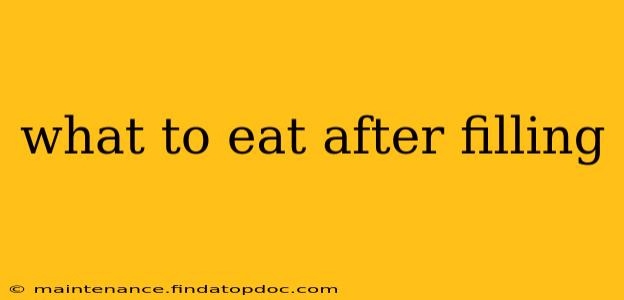What to Eat After a Filling? A Guide to Post-Filling Dietary Choices
Getting a dental filling is a common procedure, but knowing what to eat afterward is crucial for a smooth recovery and preventing complications. The immediate post-filling period requires a gentler approach to eating, focusing on soft foods that won't irritate the treated area. However, the longer-term dietary considerations are also important for maintaining the health of your filling and your overall oral health.
What should I eat immediately after getting a filling?
Immediately after the procedure, your mouth will likely be numb. This is why it's essential to stick to soft foods that require minimal chewing. Avoid anything hot or extremely cold as this can be sensitive to the recently placed filling and surrounding tissues. Good options include:
- Yogurt: A smooth, creamy yogurt is easily consumed and provides beneficial probiotics.
- Applesauce: This provides sweetness and essential nutrients without requiring much chewing.
- Mashed potatoes: A classic comfort food that is gentle on the mouth.
- Oatmeal (cooled): Choose plain oatmeal and avoid adding crunchy toppings initially.
- Scrambled eggs: Soft-cooked eggs are easy to eat and packed with protein.
- Soups (broth-based): Ensure the soup isn't too hot and avoids any hard vegetables or grains.
What foods should I avoid after a filling?
For at least 24 hours, and ideally longer depending on your dentist's recommendation, steer clear of foods that could dislodge or damage your new filling. This includes:
- Hard foods: Avoid nuts, hard candies, popcorn, and anything else that requires excessive chewing force.
- Sticky foods: Things like caramel, taffy, and chewing gum can stick to the filling and potentially pull it loose.
- Chewy foods: Tough meats, bagels, and bread crusts are best avoided initially.
- Extremely hot or cold foods and drinks: These can cause sensitivity around the filling site.
How long should I eat soft foods after a filling?
The duration you need to consume soft foods depends on the size and location of the filling, as well as individual healing responses. Most dentists recommend sticking to a soft-food diet for at least 24 hours. However, it's best to follow your dentist's specific advice, as they have the best understanding of your individual case. Gradually reintroduce firmer foods as you feel comfortable.
Can I eat crunchy foods after a filling?
Once the initial numbness has worn off and you feel no discomfort, you can slowly start to reintroduce crunchy foods. Start with softer options and gradually increase the texture as tolerated. Always listen to your body and stop if you feel any pain or discomfort.
What are the long-term dietary considerations after a filling?
Maintaining good oral hygiene is crucial, both for the longevity of your filling and your overall dental health. A balanced diet is important, avoiding excessive sugar consumption to prevent tooth decay. Regular dental checkups are crucial for monitoring the filling and ensuring its integrity.
What foods are good for healthy teeth and gums?
A diet rich in fruits, vegetables, and dairy products is essential for healthy teeth and gums. These foods provide the nutrients necessary for strong enamel and gum health. Remember that regular brushing and flossing, along with professional cleanings, are integral parts of maintaining good oral health.
By following these guidelines and consulting with your dentist, you can ensure a smooth recovery after your filling and maintain healthy teeth and gums for years to come. Remember, individual experiences vary, so always adhere to your dentist's personalized advice.
